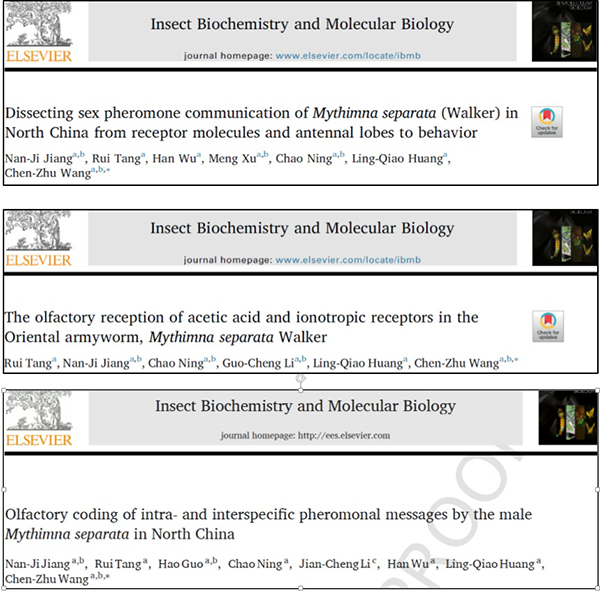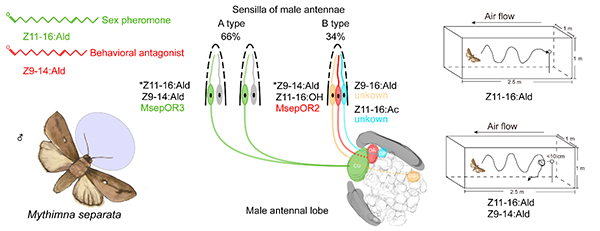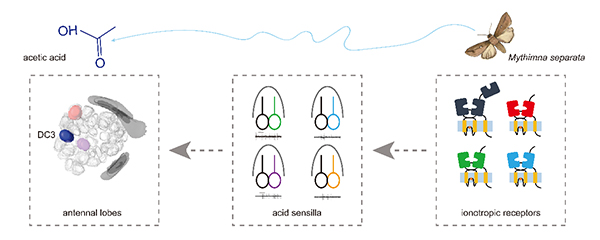The Oriental armyworm, Mythimna separata (Walker), is a major agricultural pest in Asia. It causes serious damage to cereal crops such as maize, rice, wheat and millet frequently. The adult moths have the characteristic of seasonal migration in a long distance. As a result, the armyworms appear and disappear mysteriously, and are very difficult to be controlled. For the strong attractiveness to the adult moths, both sex pheromone and sweet vinegar solution are employed to monitor the population occurrence and dynamics of this moth species. Recently, Chen-Zhu Wang’s lab in Institute of Zoology, Chinese Academy of Sciences serially published three research papers in the prestigious journal of Insect Biochemistry and Molecular Biology, and uncovered the olfactory coding mechanisms of the Oriental armyworm to the sex pheromone and sweet vinegar solution.

The sex pheromone of M. separata was reported in several previous studies, but the results on the composition and proportion of the pheromone blend are inconsistent. The sex pheromone blends identified from different geographic populations of M. separata can be roughly grouped into two clusters: one uses (Z)-11-hexadecenyl acetate (Z11-16:Ac) as the major component, and another uses (Z)-11-hexadecenal (Z11-16:Ald) as the major component. In this study, the authors introduced an integrative approach including analytical chemistry, as well as behavioral, electrophysiological, and molecular biology to investigate the female sex pheromone and male peripheral coding of M. separata to pheromonal compounds. Firstly, they examined the potential pheromone components in the pheromone gland extracts by using the gas chromatography-electroantennograhic detection (GC-EAD) and gas chromatography coupled with mass spectrometry (GC-MS). Then, they tested behavioral valences of males to a series of blends of these compounds in a wind tunnel. To investigate the peripheral coding of males to pheromone compounds, they characterized the long trichoid sensilla of males to pheromone compounds by using single sensillum recording (SSR), and then figured out the neural representations of male antennal lobes to pheromonal compounds by using the three-dimensional modeling and in vivo optical imaging. Finally, they deorphanized two pheromone receptors (PRs) in male antennae by using the Xenopus oocyte expression system and two-electrode voltage-clamp recording. The main results are as follows: (1) Z11-16:Ald is the major pheromone component of M. separata in North China, and the content of Z11-16:Ald is 16.2 ± 6.1 ng in a single pheromone gland; the single Z11-16:Ald as a lure is enough to attract males in wind tunnel. (2) Two types of long trichoid sensilla on antennae are responsible to pheromonal compounds: A type sensilla mainly respond to Z11-16:Ald and Z9-14:Ald, and B type sensilla mainly respond to Z9-14:Ald, and also to Z11-16:Ac, Z11-16:OH and Z9-16:Ald; the ratio of A and B type sensilla is 66.2: 33.8. (3) The macroglomerular complex (MGC) in male antennal lobes contain three units, which are named as the cumulus (CU), dorso-anterior (DA), and dorso-posterior (DP); Z11-16:Ald activates the largest unit CU; Z9-14:Ald activate DA at low dosage, and it activated both CU and DA at high dosages; Z11-16:OH activates DA; Z11-16:Ac activates DP; Z9-16:Ald activates the ordinary glomerulus 1 (OG1). (4) MsepOR3/ORco is mainly tuned to Z11-16:Ald, while MsepOR2/ORco is mainly tuned to Z9-14:Ald; (5) Z9-14:Ald acts as a pheromone antagonist and plays a crucial role in reproductive isolation among sympatric moth species (Figure 1).

Figure 1. The olfactory coding model of the male Mythimna separata in North China to the sex pheromone and behavioral antagonist.
The high preference of the adult moths to the acetic acid enriched sweet vinegar solution makes the Oriental armyworm a good target for exploration of undiscovered acetic acid sensing pathways. A similar integrative approach was used in the study, including chemical analysis, electrophysiological experiments, behavioral assays, optical calcium imaging, transcriptome and functional analyses. The main findings include: (1) Acetic acid is an essential bioactive component in the volatile blend of the sweet vinegar. (2) Four types (as1, as2, as3, and as4) of sensilla are involved in acetic acid perception on the antennae. (3) Low dosages of acetic acid activate one ordinary glomerulus (DC3), and high dosages evoke additional two glomeruli (DC1 and AC1) in the antennal lobe. (4)The low dosages of acetic acid are attractive to adults and induced the proboscis extension. (5) A total of 67 odorant receptors (ORs) and 19 ionotropic receptors (IRs) are identified in the antennal transcriptome of M. separata adults, and Ir8a, Ir75q1 and Ir75q2 are co-expressed in the same cells indicating that Ir8a may be the co-receptor of IRs (Figure 2).

Figure 2. The olfactory coding model of the female Mythimna separata in North China to acetic acid.
These findings not only help us understand the organization of olfactory systems in this moth species, but also lay a solid foundation for using sex pheromone and sweet vinegar solution to monitor and control the Oriental armyworm. Based on these results, it is reasonable to assume that the geographic populations investigated under the name of M. separata may belong to two different species, one uses Z11-16:Ald as the major pheromone component, and another uses Z11-16:Ac as the major pheromone component. Z11-16:Ald alone can be used for monitoring the population dynamics of M. separata in China because it is sufficient to attract males, and also simple and economical in term of practical application. Nevertheless, the pheromone lure of the Oriental armyworm and other lures containing Z9-14:Ald should not be mixed together for use in the field.
Publications:
Jiang NJ, Tang R, Guo H, Ning C, Li JC, Wu H, Huang LQ & Wang CZ (2020) Olfactory coding of intra- and interspecific pheromonal messages by the male Mythimna separata in North China. Insect Biochem Mol Biol 103439. https://doi.org/10.1016/j.ibmb.2020.103439
Tang R, Jiang NJ, Ning C, Li GC, Huang LQ & Wang CZ (2020) The olfactory reception of acetic acid and ionotropic receptors in the Oriental armyworm, Mythimna separata Walker. Insect Biochem Mol Biol 118: 103312. https://doi.org/10.1016/j.ibmb.2019.103312
Jiang NJ, Tang R, Wu H, Xu M, Ning C, Huang LQ & Wang CZ (2019) Dissecting sex pheromone communication of Mythimna separata (Walker) in North China from receptor molecules and antennal lobes to behavior. Insect Biochem Mol Biol 111: 103176. https://doi.org/10.1016/j.ibmb.2019.103176
(Contact: Chen-Zhu Wang, czwang@ioz.ac.cn)



